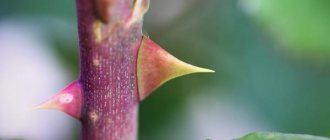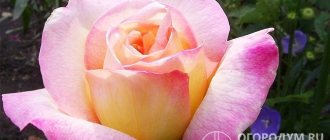The touching and quivering ground cover rose “Fairy” or “The Fairy” produces so many flowers that the greenery underneath is practically invisible. This is the most profusely flowering of all roses, which at any age is capable of producing an amazing number of flowers on one shoot.
Starting its parade late, only in the middle of summer, “Fairy” quickly turns into the most romantic accent in the design of any garden and lives up to its fabulous name until the end of autumn. But the number of flowers does not at all mean that this rose is distinguished by increased demands: “Fairy” has earned the title of royal variety largely due to its endurance.
Rose "The Fairy".
Decorative advantages of a fabulous station wagon
Thanks to its ability to bloom tirelessly from the second month of summer until the arrival of cold weather in November, “Fairy” is considered one of the best lush-flowering varieties of universal ground cover roses, which, if desired, can also be grown as shrubs. This is an unpretentious plant, resistant to diseases and pests, hardy, well adapted to harsh winters, which blooms profusely even without the most careful care.
It is no coincidence that “The Fairy” has earned the title of one of the easiest flowering or polyanthus roses to grow. She is capable of performing different, sometimes dissimilar roles, and looks great in a flower garden, in a mixed border, and in splendid isolation.
Silhouette and foliage
This rose is characterized by fairly bright, small, discreetly glossy foliage, not as dense as other ground cover roses, but very elegant.
Rose "The Fairy".
“Fairy” is a unique variety for ground cover roses. This is a bushy, widely spreading rose that can play the role of ground cover and grows significantly in width with age, but is still perceived as a compact, lush bush. One rose at maturity can cover an area of about a square meter of soil thanks to its meter-long hanging shoots, which are powerful and quite strong. At the same time, both practically straight, shorter branches and longer lashes are developing on “Fairy”.
Thanks to its beautiful drooping shoots, “Fairy” is a favorite rose for breeding standard forms. In the high-stem variation, "Fairy" is surprisingly good. She looks like a cloud of pink cotton wool and captivates with her amazingly elegant silhouette and beauty.
This rose tolerates molding well and can be given the appearance of a neat bush, restraining its growth in width and spreading throughout the soil.
Flowering time
“Fairy” blooms later than most roses, only by mid-summer, but it blooms tirelessly until frost.
Features of flowering
Repeatedly blooming and practically never slowing down, the ground cover rose “The Fairy” is covered in a blanket of densely double inflorescences in mid-summer. The flowers of "Fairy" are rosette-shaped, seem airy and very dense. Reaching only 2.5 cm in diameter, they are surprisingly lush, collected in very dense brushes, more like bunches, making each individual flower seem larger. Each shoot of this rose can bloom up to 25 flowers (and with good nutritional soil and constant maintenance of its moisture, their number exceeds four dozen). The number of flowers on “Fairy” is so large that the attractiveness of the plant itself is practically invisible underneath them.
Rose "The Fairy".
The aroma of roses is very delicate, practically not felt, only at a close distance its enchanting overflows are caught.
“Fairy” inflorescences, despite their modest size, always attract attention in floristry. These small, but dense flowers last a very long time when cut, which allows you to create bouquets of roses that do not lose their attractiveness for a much longer time.
Color spectrum
The color of the flowers is pale pink, soft, romantic, different on almost every flower; watercolor stains from a richer pink to almost white are observed throughout the bush, which only emphasizes the romantic status of “Fairy”. This effect of color changes and transitions is inherent in “Fairy” due to the fact that after blooming, bright pink flowers gradually fade to almost a white color. If the weather is cold and cloudy, the flowers can completely retain their rather rich color.
The disadvantages of this rose include the tendency of flowers to burn out. In the bright sun, especially under the midday rays, the pink watercolor of beautiful flowers is quickly lost, and the color becomes unattractively faded. This is why it is so important to plant the rose in places where it will not be illuminated by the sun at midday.
Description
The Fairy rose bush is so lushly strewn with flowers that sometimes it is even impossible to detect foliage under the buds. Gardeners will also like the fact that the exquisite beauty of the plant is combined with unpretentiousness and low maintenance requirements. Fairy rose can be grown as a bush plant and as a ground cover.
In the USA, this variety was awarded 70 times in the category “Best Polyanthus Rose”, and from 1997 to 2012 the Fairy rose received the Grand Prix in this category every year. Currently, the variety is one of the 10 best polyanthus rose varieties in the world.
Of all the types and varieties of roses, Fairy is the most profusely blooming. The plant in bloom looks extremely romantic, creating a fabulous, magical atmosphere on the site. But along with this airiness and fabulousness, the plant surprises with its amazing endurance and stability. It can bloom well even in conditions of careless, infrequent care.
Features of the bush
The plant is distinguished by its branching and lushness, and grows strongly. And the older the rose bush, the more voluminous it becomes. The Fairy reaches a height of 1.2 meters, while the shoots of the plant are powerful, strong, but slightly drooping (see photo). Thanks to this quality, the variety is often used for breeding new standard roses.
The bush grows at an average rate. And thanks to the rose’s excellent tolerance to pruning, the gardener has the opportunity to easily form a bush and control its growth and size.
Features of flowering
Due to the original rosette-shaped shape of the buds, the bush does not look heavy, even if it blooms very luxuriantly. Each bud reaches a diameter of 3-5 cm, individual specimens are collected in inflorescences of 10-20 pieces.
Description of color: the color of the petals is pink, the structure is terry. One bud has about 40 petals. Under the sun, the color tends to fade and by the end of flowering the buds usually turn pale.
The ground cover rose begins to bloom later than others. This allows you to use the plant to decorate many interesting floral compositions. The first flowers bloom only in July, and flowering stops in October. A big plus is flowering without interruption.
Roses have virtually no scent - a barely audible aroma can only be detected from a very close distance.
Kinds
Separately, it is worth mentioning such a variety as Yellow Fairy. This rose has all the same advantages as Fairy, and differs only in the color of the petals: they are yellow.
Fairy Yellow is very decorative and is also a ground cover. It blooms profusely and luxuriantly, is easy to care for, does not require frequent pruning, and is resistant to cold weather. And its delightful-looking flowers will decorate any garden plot.
The Tail and Iles varieties are also interesting. The Fairy Dance and Changeling varieties are very decorative.
Landscape design
The Fairy variety is widely used for landscaping and decorating a wide variety of garden, park and urban landscapes. The flower has a universal use and looks great anywhere.
You can plant the rose as a bush, border or ground cover. And with regular pruning, you will get a wonderful compact dwarf shrub or even a standard weeping variety.
Can be used as a hedge (though the hedge will be quite low). The rose will also make a magnificent background, highlighting the beauty of other plants. Can also be grown in containers and tubs.
It prefers to live side by side with perennials, low-growing shrubs, drooping and climbing specimens. The following plants are suitable:
- lobularia;
- lavender;
- bells;
- violets;
- decorative cereals, etc.
The combination of Fairy with other roses, especially with their miniature representatives, looks impressive. Pink plantings look charming against the backdrop of elegant coniferous plants.
Attention: it is better to avoid combinations of pale pink Fairy and flowers with yellow and orange colors, as the rose will look inconspicuous against such a background.
Fairy rose creates a dense carpet of lush flowers on the site, does not require careful care and frequent pruning, and is able to withstand unfavorable conditions. All these features enable the gardener to use plants to decorate a variety of places on the site that are inaccessible to other plants.
What to look for when purchasing
When purchasing “The Fairy” seedlings, you must give preference to plants with an open root system. They should be characterized by a fairly large number of shoots, developing from one powerful base. Do not buy a rose that “splits” already at the grafting site, branches poorly at the top, and develops one-sidedly. Please note that the leaves on the rose should not be loose, and even more so, you should not buy seedlings with yellowed leaves. The rhizome should be branched, bunch-shaped, dense and very strong.
Rose "The Fairy".
Seedlings need to be purchased immediately after digging: the longer Fairy seedlings are stored without soil, the more their adaptability suffers and the worse the roses will take root in a new place. Please note that the roots of the plant must be fresh, in no case overdried, the entire plant must be healthy, without stains or damage.
Use in landscape design
Rose "Fairy" is known as one of the best flowers for landscaping garden plots and public places. Its application is universal. The plant can be grown, excluding pruning, as a shrub, ground cover or border species. If its owner prefers to do regular pruning, then the rose will turn out to be an excellent dwarf shrub or weeping standard species. When forming a trunk, the bush looks great as a weeping species.
The variety can be used for planting as a low hedge. When placed in the foreground it will make a great border decoration. Can also be used in container planting.
The best neighbors of this pink bush will be low-growing bushes, perennials, and climbing crops. Delicate pink buds are in perfect harmony with horned violet, bluebells, lavender, white lobularia, ornamental grasses, and other types of roses.
Conditions comfortable for “Fairies”
Unlike most ground cover roses, "Fairy" is a light-loving rose, but not the most sun-loving rose. She prefers areas that are brightly lit for only half the day, where the plant will not suffer from midday rays or will be shaded from the sun by other plants during the hottest time of the day. "Fairy" can be grown even in partial shade, but the number of flowers in poorer light will be correspondingly reduced. In partial shade, this variety stretches upward and hardly grows in breadth. When choosing a location for “Fairy”, you should categorically avoid all southern sides of buildings, rock gardens, and the hottest places on the site.
It is quite easy to choose the soil for this rose. It should be loose, light in texture, and allow water to pass through well. High fertility rates are only welcome. It is believed that this rose can bloom beautifully even on poor soils. But without access to a large amount of nutrients, "Fairy" will produce fewer flowers and will suffer from diseases and pests.
Rose "The Fairy".
When choosing a soil mixture for “Fairy” specimens growing in containers, select special substrates intended for growing flowering plants or special soil for roses.
Reviews
Rose Fairy is one of the few varieties about which there are practically no negative reviews on the Internet. All flower growers who responded are happy with the unique plant, its external showiness and splendor, and unpretentiousness.
It is noted that with age, the external splendor of Fairies only increases, while the beauty of the plant is not intrusive or rude. Gardeners praise the continuous flowering of the bush and note the hassle-free, problem-free cultivation of roses.
Among the positive qualities, the strength and endurance of the plant, its resistance to weather disasters and diseases, and good tolerance of our harsh winters are also noted.
Rare negative reviews only affect the plant's late flowering and lack of aroma. In addition, some gardeners speak out about the sloppy flowering of the plant: but most other flower lovers do not support this opinion.
Fairy rose is a magnificent decoration of the garden landscape, while being sweet, pleasant and unobtrusive. It is not difficult to grow a shrub and care is not difficult. Fairy Rose will fully satisfy the aesthetic needs of any gardener, without requiring any special labor or time expenditure.
Planting a rose
Before planting, be sure to improve the soil. Spread as much mature compost and complete mineral fertilizers over the surface as possible. Dig the soil deeply throughout the rose growing area and carefully select weed rhizomes, large breasts and stones.
When planting “The Fairy”, keep a distance of about 50 cm from large plants, other roses and shrubs. The “Fairy” rose, even in the middle zone, can be planted in both spring and autumn.
The Fairy rose is planted in individual planting holes, the size of which is selected according to the size of the rhizome, with an increase of 15 cm for drainage. It is best made from gravel or crushed stone sprinkled with sand.
Before planting, long roots on seedlings must be shortened, and all shoots on the rose must be cut to a level of 10-15 cm. Place the rose on a small mound of earth so that the grafting point is 3-4 cm below the ground line. If you are growing a standard form, then before installing the rose in a container or planting hole, be sure to place a support in the middle to which you can tie the rose. After filling the substrate around the entire perimeter of the planting hole, create a cushion of soil that will prevent water from spreading during watering. It is better to water this rose fairly regularly over the next 2-3 weeks after planting to speed up adaptation.
Rose "Fairy" ground cover: where to place?
Choosing a location, preparing the soil, and applying fertilizers are important factors in the quality growth of any garden crop. Rose "Fairy", considered an example of lush flowering varieties, prefers to grow in well-lit areas. Optimal access to sunlight will ensure high-quality formation of buds and long-term continuous flowering. Bushes placed in partial shade will respond to lack of lighting by increasing green mass.
The optimal place for planting a rose bush is considered to be the western and southeastern parts of the site, where in the first half of the day the plant will receive the necessary portion of ultraviolet radiation, and at noon it will be under the shady protection of nearby trees and shrubs.
The fairy rose feels most comfortable in soil that is fertile, light in texture and well permeable to water. For container specimens, it is recommended to use a special substrate for flowering plants.
Caring for "Fairy"
Watering "Fairy" is needed only during drought, especially at the budding stage and at the beginning of flowering. At this time, lack of precipitation can significantly affect the number of flowers produced, so it is better to carry out deep watering every 5-7 days to saturate the soil with moisture.
Rose "The Fairy".
The first fertilizing for "Fairy" is applied in early spring, immediately after removing the cover. It is advisable to use special mixtures of mineral fertilizers for roses and organic fertilizers. The second must be carried out at the budding stage, using phosphorus-potassium fertilizers (superphosphate and potassium sulfate) or once again applying special fertilizers for roses.
The reputation of this variety as a somewhat sloppy rose is absolutely not justified. With even minimal care, “The Fairy” retains its attractiveness and surprises with truly tireless flowering year after year. In order for “Fairy” to always look neat and impeccable, it is enough to shake off or trim the faded flowers and sometimes adjust the bush as desired, cutting off thickening or unruly, too long branches. In early spring, sanitary pruning is required on Fairy. All damaged and dried shoots are removed from the bushes.
Otherwise, caring for “Fairy” comes down to:
regular loosening of the soil when a crust appears;
timely weeding or mulching that replaces it, which will reduce the number of watering procedures and save you from the need to remove weeds.
Pruning activities
Rose The Fairy is a fairly unpretentious plant, adapts well to cold winters, and can delight with flowering even in the absence of constant care. It tolerates molding well, so a garden crop can easily be given the image of a neat bush, restraining its growth in width and height. If necessary, to ensure good ventilation and light, it is recommended to thin out the bushes. In the first year, the stems should be shortened in order to activate tillering, then the annual spring pruning is of a sanitary nature and consists of removing old, diseased and dried branches. Every 5-6 years, the ground cover rose “Fairy”, reviews of which are positive and encourage you to acquire such a lovely plant on your own plot, needs rejuvenation: all lashes need to be cut short, leaving 20-30 cm each. During this procedure, cuts larger than 1 cm is recommended to be covered with garden varnish, and the bush to be treated with a solution of copper sulfate or Bordeaux mixture.
Many experts do not recommend pruning the Fairy ground cover rose in order to preserve its natural shape. In this case, it is important to plant the plants in such a way that they do not interfere with each other.
Preparing for winter
“Fairy” often freezes slightly in the middle zone, but quickly recovers. Usually this rose overwinters well with light hilling. It is better to protect young roses more reliably:
Tall, erect shoots on bushes are shortened by a third of their height in late autumn, and all leaves are removed from the bushes.
The base of the bush is covered with earth or compost.
The shoots are covered with brushwood, spruce branches or wrapped in burlap.
Rose "The Fairy".
Standard roses bred on the basis of “Fairy” require a very special approach to wintering. It is best to preserve the tall-trunked “Fairy” by putting it indoors for the winter. But if the rose does not grow in a tub, it needs to be dug up on one side and bent to the ground, covered using air-dry methods, hilling and spruce branches, leaves and non-woven materials. There is another option - hill up the base of the leg, carefully wrap the trunk with non-woven material, and cover the crown using the air-dry method.
Lovely garden charm
Collected in airy brushes (10-30 pieces each), double pale pink flowers, arranged in a dense wall on powerful hanging shoots, are associated with a light cirrus cloud and are a bright accent in the design of any garden. Small in diameter (about 2.5 cm), they look very lush and rich.
The flowering period lasts quite a long time - from mid-summer until the onset of the first frost - and is accompanied by a light apple aroma.
Pests and diseases
The greatest danger to roses of this variety is powdery mildew. It manifests itself in a whitish coating, which primarily appears on the young parts of the plant. Sometimes downy mildew can be observed on this rose, which affects only the lower sides of the leaves. It is better to combat both diseases with special medications.
The most winning games in garden ensembles:
in lush hedges;
in borders around the rose garden and flower beds, in zoning areas;
as a separator plant or lawn decoration;
on supporting walls, in rock gardens and rock gardens, where the effect of a cascade of branches is perfectly revealed;
in standard form: “Fairy” will decorate any potted garden, flower bed or bed, looks great in containers and
pots as “guardians”;
to create a surprisingly lush background in flower beds, under fences, and walls of buildings;
in landscape ensembles and lush flowers in a romantic style;
in continuous flowering mixborders.
Rose "The Fairy".
How and when to water?
It is very important to provide the rose with abundant watering during dry periods, as well as at the stage of bud formation and at the beginning of flowering. Depending on the size of the plant, the volume of water per unit is from 10 to 15 liters. It is better to carry out this procedure in the morning, directly under the bush, using only warm water. For good rooting, young plants should be supplied with moisture at least once a week. The number of waterings needs to be reduced. In underwatered plants, flowers become smaller and the flowering period is quite short.
The best partners for Fairies
Finding worthy companions for “Fairies” is not at all difficult. This variety of ground cover roses combines with all types of other roses, including miniature and climbing roses. But it combines just as well with perennials. "Fairy" looks great in the company of horned violet, catnip, bluebells, lavender and other classic partners for roses. Fairy flowers look very good against the background of white lobularia. Foxglove, ornamental grasses, speedwell, wormwood, chistema and other plants with silvery leaves will also be excellent companions for this rose.
This variety of roses cannot be combined in compositions only with perennials and annuals with a yellow or orange color palette. They seem dirty and even if there is a lot of color, the rose loses its attractiveness.
History of creation and characteristic features
The main ancestor of ground cover roses is rightfully considered Rosa rugosa rubra - Japanese or wrinkled rose, but in our country it is called rose hips. The homeland of these flowers is eastern Asia: Korea, Japan, northeast China and has even been spotted in southeast Siberia. Rose hips grow preferably in coastal areas on sandy areas.
Briefly about the development of the assortment
In 1796, rosa rugosa gave rise to a whole subclass of creeping roses, which are capable of covering a huge area of land. Gardeners also used another type of rose for selection - Rosa wichurana , which was used in the mid-19th century to form so-called flower carpets in landscape design.
In the 20-30s of the 20th century, several more varieties of roses appeared, among which Fairy and Max Graf were the best. These were the first flowers among ground cover roses. Closer to the 60s, breeders developed the currently popular Sea Foam and Nozomi (it can be seen in the title photo).
Then Fairy, Fiona, Bionica 82 and other flowers were added to the existing varieties, which were the result of the work of the French company Meilland Star Rose.
Rose variety from the Drift series - Coral Drift (Coral Drift)
And already in the 2000s, Meilland, by combining ground cover and miniature roses, achieved the appearance of the Drift variety series , the peculiarity of which was their compactness, short stature, vitality and, of course, beauty.
Ground cover roses have many different advantages, but the most important are:
- unpretentiousness;
- ease of propagation by layering or cuttings;
- excellent resistance to pests, diseases and frost;
- no need for annual pruning by a specialist;
- ability to suppress the development of weeds from the age of 2 years;
- rapid rooting of shoots and strong vegetation, resulting in a fairly dense carpet of flowers.
Feeding
From April to October, it is necessary to carry out feeding activities: in the spring (2 weeks after the appearance of leaves) - with mineral and organic preparations, during the formation of buds (a month after the first feeding) - with phosphorus-potassium fertilizers. In the autumn season, in order to ensure good ripening of the shoots, fertilizing with potassium preparations is recommended.
Rose "Fairy" is quite frost-resistant - the plant can easily survive the winter under snow cover, while maintaining its leaf crown. However, in conditions of snowless and harsh winters, a light cover with spruce branches will not hurt.











